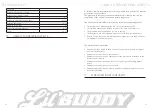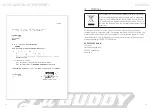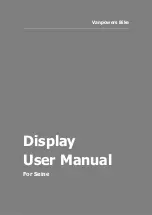
14
15
The pressure point is the lever position of the travel at which the
brake is engaged. If brakes function smoothly - there are no air bub-
bles in the hydraulic line - the pressure point is situated at the same
lever position at each braking action.
Do not touch the brake discs with your hands. The thin grease film
on your skin is transmitted to the brake discs and affects its func-
tions.
3.3.
CHECKING THE CHAIN
The chain is a product subject to wear. Please check regularly the following
items:
»
Are there any foreign objects (twigs) between the chain links?
-> If so: Remove them.
»
Is the chain very dirty?
-> If so: Rinse it with water or a proper cleaning solution. Then use a first
class chain lubricant.
»
Lubricate the chain at regular intervals, even when it is not dirty, in order to
prevent it from significant wear.
3.4.
BATTERY: CHECKING THE FIXATION AND CHARGING STATUS
Check whether the battery is secured in the lock and see whether the charg-
ing status is sufficient for your planned ride.
3.5.
CHECKING THE FORK
Before each ride, check the fork for:
»
Breakage and deformations
»
Secure fixation of the protective plate
»
Firm screwing connection of the fork bridge
BEFORE EACH RIDE
3.
BEFORE EACH RIDE
3.1.
CHECK TIRES
Tire pressure:
The allowed pressure range of the 20“ 98-406 is between 1 and 1.5 bar.
The following applies:
The higher your weight, the higher the air pressure
to be used.
If you are not a light-weight person, set the pressure
of your rear tire at 1.5 bar.
We recommend to check the pressure every 2 - 4 weeks, since there
is an inevitable constant pressure loss of the inner tubes.
With a too low tire pressure, a puncturing hazard exists (snakebites).
This will result in a flat tire.
A tire that is damaged by tears or punctured by a sharp object may
loose its pressure. A hazard of accident exists!
-> Check that your tires are without tears or any foreign objects.
3.2.
CHECKING THE BRAKE SYSTEM
»
Before each ride, check your brakes at standstill. For this purpose, pull the
brake lever towards the handlebar with two fingers for a normal braking
force. The brake lever must not touch the handlebar grip
»
Move the Pedelec while pulling the front and rear brakes. A too strong a play
is not allowed. If you notice any play, identify the cause. The brake calliper or
brake disc may not be tightened firmly. Tighten according to the torques in
the torque table in chapter 9.3.
»
If hydraulic brake discs are used, the pressure point must be stable at the
brake lever. If the pressure point is not reached after 2/3 travel of the lever,
pull the lever several times in a row (“pumping”). Check whether the pressure
point has stiffened. If so, or when the pressure point changes during the ride,
bleed the brake system by a specialist workplace.
»
The brake discs must be oil-free. Any oil on the brake discs is removed with
alcohol. Do not use a conventional brake disc cleaning solution!
BEFORE EACH RIDE





































